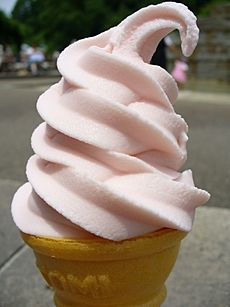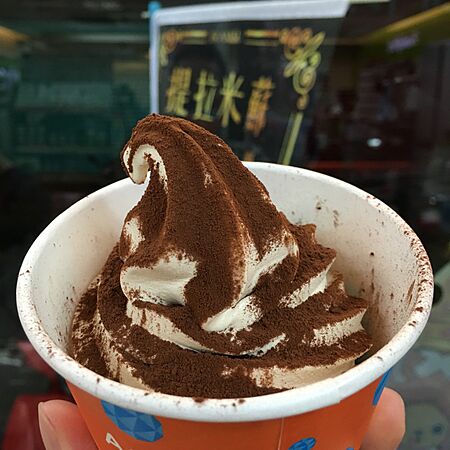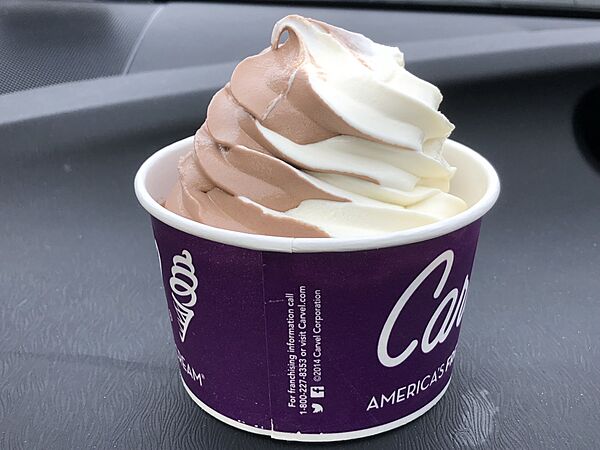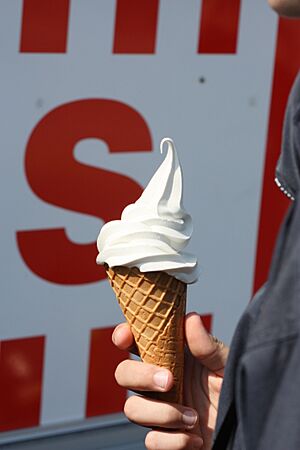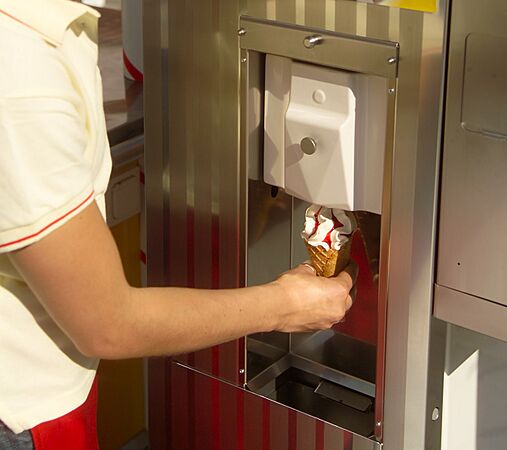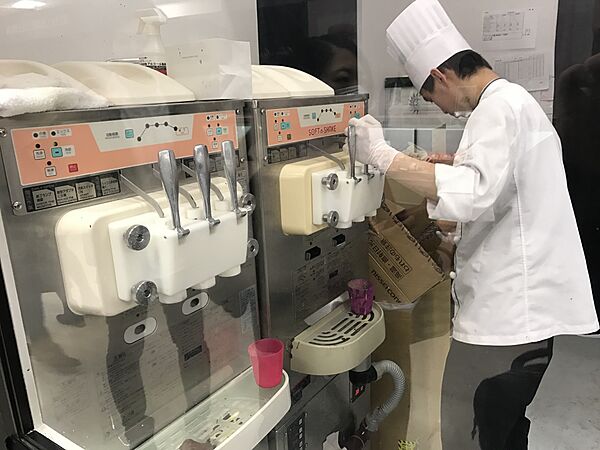Soft serve facts for kids
Soft serve is a yummy frozen treat. It's a lot like ice cream, but it's softer and lighter. This is because air is mixed into it while it's freezing. Soft serve has been sold in stores since the late 1930s in the United States.
You usually won't find soft serve in grocery stores. Instead, it's popular at fun places like fairs, carnivals, and amusement parks. Many restaurants, especially fast-food places, also sell it. To make soft serve, a special machine keeps the mix very cold, but not frozen, right where it's served. This helps stop ice crystals from forming.
Contents
How Soft Serve Began
The idea for soft serve machines started a long time ago. In 1926, Charles Taylor from Buffalo, New York, got a patent for an automatic ice cream maker. People say this was the first soft-serve machine! His company, Taylor Company, still makes machines today, including the ones used for McDonald's ice cream.
Another famous story is about Tom Carvel, who started the Carvel ice cream shops. In 1934, his ice cream truck got a flat tire in Hartsdale, New York. His ice cream started melting, so he sold it right there to people driving by. He sold all of it in just two days! This made him realize that selling soft, melting ice cream from a fixed spot was a great business idea. In 1936, he opened his first store and created his own secret soft serve recipe.
Dairy Queen also says they helped invent soft serve. In 1938, J. F. McCullough and his son, Alex, created their own soft serve recipe. They tried selling it for the first time on August 4, 1938, in Kankakee, Illinois. They sold over 1,600 servings in just two hours! That's super fast.
There's a common story that Margaret Thatcher, who later became the Prime Minister of the UK, worked as a chemist for a food company called J. Lyons and Co. in the late 1940s. This company was working with an American company, Mister Softee, to make a soft-serve recipe. While her exact job at Lyons isn't fully clear, she did work on the quality of foods like cake fillings and ice cream.
In the 1960s, ice cream machine makers added air pumps to their machines. This made the soft serve even lighter and better. A Danish ice cream shop owner named Johannes Laursen discovered that using an aquarium pump made the soft ice lighter and tastier. His idea was later used by an Italian ice cream maker, but Johannes Laursen was still recognized for his discovery. His special soft ice, "Gudhjem Special," became very famous in Denmark.
What Makes Soft Serve Special?
Soft serve usually has less milk-fat (about 3% to 6%) than regular ice cream (which has 10% to 18%). It's also made at a warmer temperature, about -4°C, while regular ice cream is stored at -15°C.
One big difference is the air mixed into soft serve. This air is called overrun. It can make up 0% to 60% of the final product's volume. The amount of air changes how it tastes.
- Less air makes it taste heavier and icier, and it looks more yellow.
- More air makes it taste creamier, smoother, and lighter, and it looks whiter.
The best amount of air is usually between 33% and 45%. If there's too much air, it loses flavor and melts faster. If there's too little, it might not taste as good.
Soft serve needs to be frozen quickly to stop large ice crystals from growing. If soft serve is stored below freezing for too long after it's made, it will become solid. That's why it's made fresh by a special machine right where you buy it.
The machine works like this: 1. A pre-mixed liquid (the "mix") is put into the machine's storage part, kept at about 3°C. 2. When you pull the handle to get soft serve, fresh mix and air are pulled into a freezing part. 3. There, it's quickly churned and frozen. Then it's ready to be served!
Some soft serve machines can even make two flavors at once! They have an extra nozzle that mixes two different flavors, creating a cool swirl pattern. This is often called a swirl or twist flavor.
Different Kinds of Soft Serve Mix
The pre-mix for soft serve comes in a few forms:
- Fresh Liquid: This mix needs to be kept cold all the time. It can last about 5 to 7 days before bacteria might spoil it. People who handle it need to be very careful to keep it clean.
- Powdered Mix: This is a dried version of the liquid mix. It's easy to ship and can be stored for a long time without going bad. You just add water to it before putting it in the machine. The downside is that the water quality might not always be perfect, and some people might add too much water to make it last longer. It should also be chilled before use to prevent bacteria from growing.
- Ultra Heat Treated (UHT) Mix: This liquid mix has been sterilized and sealed in special bags. It can last a very long time without needing to be refrigerated until you open it. Once opened, it should be chilled before use. Health experts often say this is the safest type of soft serve mix because it starts out completely free of bacteria. It was first made in New Zealand in 1988.
Names for Soft Serve Around the World
Soft serve has many different names in different places!
- 99 or 99 Flake is a term used in Ireland and the UK. It technically means soft serve in a cone with a Cadbury's Flake chocolate bar.
- American ice cream is used in Israel and Lebanon.
- Candy (pronounced with a Spanish accent) is used in Argentina.
- Cream ice cream (krémfagylalt) is sometimes used in Hungary.
- Creemee is popular in Vermont and other parts of New England, often made with maple syrup.
- Crème glacée molle is used in Quebec, Canada.
- Hard serve is a term used in New England to tell regular "hard" ice cream apart from soft serve.
- Italian ice cream (glace à l'italienne in France, sorvete italiano in Brazil, lody włoskie in Poland) is used in France, Brazil, and Poland.
- Lucky cream is used in Syria.
- Machine ice cream (helado de maquina in the Dominican Republic, inghetata la dozator in Romania, сладолед от машина in Bulgaria, παγωτό μηχανής in Greece, gépifagyi in Hungary) is used in these countries.
- Merry Cream is another term used in Lebanon.
- Mr. Whippy is used in the United Kingdom and Australia, especially when sold from an ice cream truck.
- Softcream (ソフトクリーム) is used in Japan. It can be sweet or savory, with unique flavors like powdered tea, wasabi, sesame, and plum.
- Pehmis is a term used in Finland.
- Semi-frozen (semi-frio) is used in Portugal.
- Soft ice (Softeis in Germany, softijs in the Netherlands and Belgium, softis in Norway) is used in Norway, Germany, Denmark, the Netherlands, and Belgium.
- Soft ice cream (mjukglass) is used in Sweden. Also, Gelat tou is used in Andorra and Catalonia (Spain). In Greater China, it's called Chinese: 软冰淇淋; pinyin: ruǎn bīngqílín), Cantonese: 軟雪糕; Jyutping: jyun5 syut8 gou1 and Chinese: 霜淇淋.
- Soft whip is used in Ireland.
- Softee or softie is used in India, Pakistan, and Australia.
- Ice cream Softserve or I-Tim (ไอศครีม ซอฟเสริฟ or ไอติม in Thai) are used in Thailand.
Gallery
Soft serve in a cup
Soft serve in waffle cone
Soft serve machine
See also
 In Spanish: Helado suave para niños
In Spanish: Helado suave para niños


